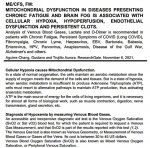@Aguirre-Chang Thank you for posting sand for your explanations. I have already done extensive testing and treatment and find some similarities to what you describe but I have some questions...
My d-dimer runs a little high. I have a Factor 2 (prothrombin) mutation and have already been treated for persistent infections (chlamydia and mycoplasma pneumonias, Epstein Barr, HHV6, cytomegalovirus and HSV1 as well as toxins. Therefore, does your theory apply? My fibrinogen is always near or over top of range - 390-500.
Ive been taking 1-3g lysine for 5 years, due to low value on tests and the herpes infections. Should I do this test? I've been on Valcyte for a total of over 26 months out of the past 5 years.
I can do a great deal of activity, walking over 10,000 steps a day, on average. However, increased pace or intensity, i.e. aerobic exercise for more than 3 minutes crashes me. I get a drained feeling in firearms and lower legs, dizziness and a need for eyes closed and total rest, but usually able to recover within 20 minutes and return to normal activity, other times, I have post-exertionsl malaise for days. Treadmill metabolic testing has shown very abnormal results - my mitochondria prefer to use glycolysis and only rarely fatty acid oxidation, so it has been hypothesized that I deplete muscle glycogen stores too quickly. I am never out of breath, and heart rate never exceeds 105 even at maximum effort.
I can believe muscles are not getting adequate oxygen, but think there's more going on, wouldn't you agree?
Agree, but this is temporary. Seems to relate to oxidative stress.
I have been greatly helped by Kuvan, a firm of tetrahydrobiopterin (BH4) which repeatably increases my exercise capacity, I believe, due to increased nitric oxide production and decreased peroxynitrite production which damaged membranes. I've also been helped by lipid replenishment which repairs these membranes.
A PET scan has a huge amount of radiation and is virtually impossible for patients without suspected cancer to get. SPRCT also has radiation?? And is difficult to get.
ok, what exactly does the doctor order, at what type of lab? E.g. can I order it at LabCorp or Quest Diagnostics, 2 major US labs or do I need to go to a hospital or reseaarch institution?
I will say that my autonomic neurologist explained that I had hypoparathyroidism in my brain when I fainted on a tilt table test... Does this count? (We think this is caused by adrenergic and muscarinic antibodies, however...)
So, I've been extensively tested and treated for bacterial and viral infections, toxins, autoimmunity, and neck trauma. I'm a lot better, but not cured and d-dimer and fibrinogen still run high, but again, I have Factor 2.
What about NO status, peroxynitrite damage to cell membranes, lipid replenishment, and gut malabsorption due to leaky gut? There are other studies that show these things in ME/CFS patients, hence my curiosity about this.
Thank you very much!😃


